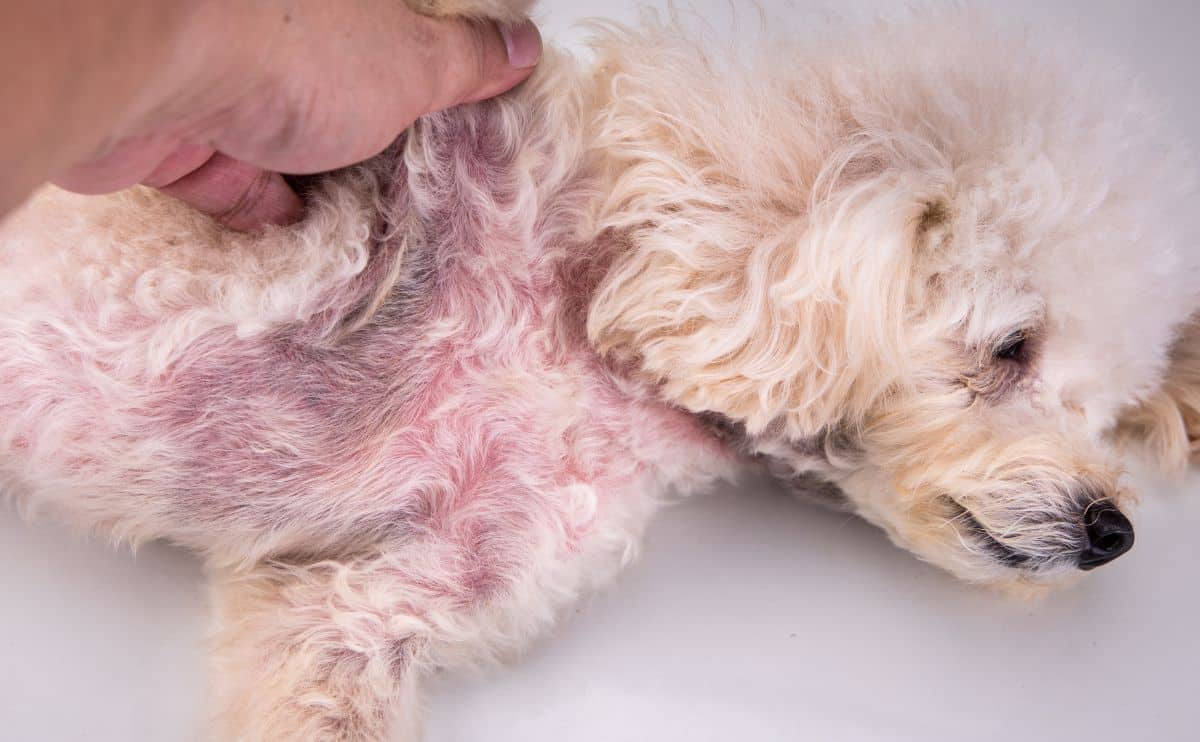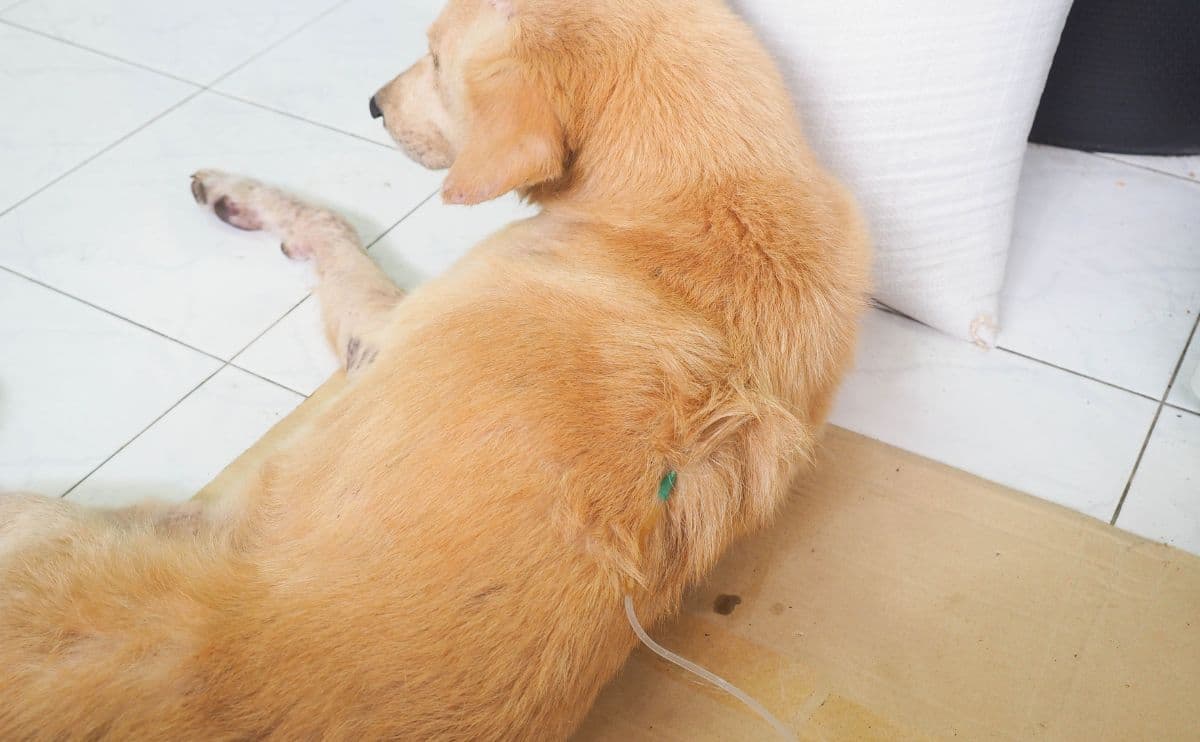When you purchase through links on our site, we may earn a commission. Here’s how it works.

Have you ever noticed that your dog has developed a particular smell, perhaps from their ears, their skin folds, their mouths, their bottom, or just in general? You might be surprised to know that it’s not uncommon for people to bring their pet to a vet because they smell! Although this might seem unnecessary, it’s important to get your dog checked over by a vet if they start to smell bad or just different from normal. Changes in smell could mean bad teeth, kidney disease, diabetes, an abscess, full anal glands, or maybe a yeast infection. But what is a yeast infection in dogs? Let’s find out everything you need to know about this smelly situation.
What Causes Yeast Infections In Dogs?
Yeast infections in dogs are caused by an overgrowth of fungal yeasts like Malassezia on the skin or in the ears. Rather than being a contagious infection that has been transferred from another dog, animal, or person, a yeast infection develops from normal yeast on the skin.
These normal yeasts live alongside bacteria as skin commensals and usually don’t cause any problems. However, in certain conditions, the yeasts can multiply, leading to symptoms.
Triggers for yeast overgrowth include skin allergies, seborrheic dermatitis, and greasy or oily skin. Yeast infections can also develop in skin folds where there’s no airflow or after a change in dog shampoo or bathing regime.
What Are The Dog Yeast Infection Symptoms?
The symptoms of a yeast infection in dogs will depend on the location of the yeast overgrowth. However, in general, you’ll notice a yeasty smell, redness, soreness, and flaky or oozy skin, and your dog may scratch, lick or bite.
Yeast Infection In A Dog’s Ear
One of the most common sites for yeast infections in dogs is their ears. If your dog has a yeast infection in their ears, they might shake their head a lot and scratch or rub their ears. If you look more closely at their ears, you might find that the canals look red, inflamed, and sore, and you might notice the typical yeasty smell.
What Causes Yeast Infections In A Dog’s Ear?
As with any yeast infection in dogs, the cause is an increase in the number of yeasts living on the skin rather than the arrival of a new yeast. Yeast overgrowth on the skin of the ear canals causes irritation and disruption to the skin barrier, meaning bacteria can take advantage of the weakened immune system and add to the problem.
Overgrowth of yeast within the ear canals can be caused by skin allergies to food, pollen, parasites, or other allergens. Still, it can also be due to swimming or having long pendulous or fluffy ears that don’t allow much airflow.
What Foods Cause Yeast Infections In Dogs’ Ears?
The most common food allergens in dogs are beef, chicken, and milk. However, not all allergies are food allergies, and some other causes of yeast infections in a dog’s ear aren’t allergy related. Similarly, not all ear infections are caused by yeast, so a veterinarian needs to check. If they are unsure of the cause of the ear infection, the vet might take a swab from the ear to look under the microscope for bacteria and yeasts so that they can prescribe the correct treatment.
How To Treat A Yeast Infection In A Dog’s Ear
A yeast infection in a dog’s ear will need to be treated with antifungal medication, which can be prescribed by your veterinarian. There are also ear flushes and solutions that reduce the pH of the skin of your dog’s ear canal to make it less likely that the yeast will overgrow.
However, if there is an underlying cause of yeast overgrowth, like an allergy, this will also need treatment for the condition to improve. Many ear medications will contain both antibiotics and antifungal medication because it’s so common for secondary opportunistic infections to occur.
Is There A Home Remedy For Yeast Infection In A Dog’s Ear?
Sadly, no home remedy will cure a dog’s ear infection, as it requires veterinary treatment. However, to try to reduce the likelihood of your dog developing a yeast infection in their ears, clean their ears regularly with a pet-safe ear cleaning solution, especially if they like to swim! Keeping the fur trimmed and groomed around their ears will also improve airflow, which will help to prevent an ear infection.
Dog Skin Yeast Infection
Another common location for a yeast infection is on the skin and within the skin folds. Skin infections are particularly common in wrinkly breeds with lots of skin folds, like pugs, boxers, bulldogs, and shar peis, but any dog can be affected. In dogs with seborrheic dermatitis and excess skin oil production, yeast overgrowth may affect the skin of their back.
However, if it’s an allergy that’s the underlying cause, you might notice a yeast infection in your dog’s paws, causing them to lick their paws excessively. In dogs, groin area yeast infections are also reasonably common, and you might notice that the skin looks thickened and wrinkly like elephant skin or that it’s become darker and more pigmented.
Female Dog Yeast Infections
Just like female humans can get yeast infections, so can female dogs. A female dog’s skin folds around their vulva and can be a breeding ground for yeast and bacteria, leading to itchy, sore skin with a yeasty smell. If your dog has vulval skin fold dermatitis, you might notice her licking excessively and scooting too. Thankfully, a veterinarian will be able to prescribe appropriate medication, including cream or tablets, to improve the symptoms.
How To Prevent Skin Issues
Dog yeast infections come in lots of different forms, so the treatment can vary from topical treatments like ear drops, creams, and shampoos, to tablets. The most important factor in successfully treating your dog’s yeast infection, though, is to find out the underlying cause and treat that too. Prevention is also important, and you might try giving your dog food specially made for dogs with skin allergies. Learn about other common skin conditions in dogs. And find out how pet insurance can help save you money and help cover vet-related expenses should your dog get a yeast infection.
Tagged With: Ears, Skin

